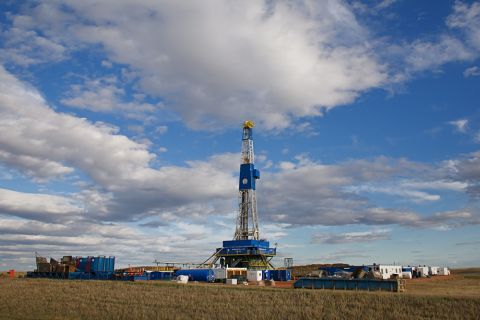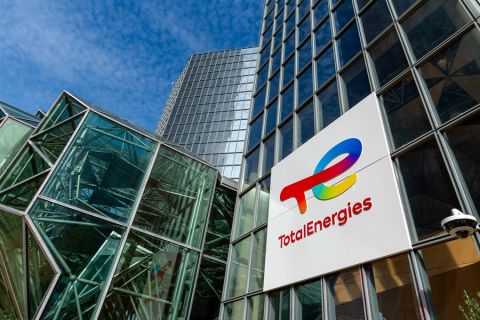The Equatorial Atlantic Transform Margin is now believed to be conjugate to the highly-productive Transform Margin of West Africa, with a number of oil and gas companies both large and small aiming to replicate the giant finds being made offshore Ghana and elsewhere.
Their expectations were given a major boost by the September 2011 discovery of the Zaedyus oil field in deep waters offshore French Guiana. Operated by Tullow Oil, which has had tremendous success across the Atlantic offshore West Africa with giant finds like the Jubilee field offshore Ghana, the GM-ES-1 wildcat in the Guyane Maritime license was a major breakthrough. The well drilled by the ENSCO 8503 semisubmersible rig in 2,048 m (6,719 ft) water depth encountered 72 m (236 ft) of net oil pay in two turbidite fans with good-quality reservoir sands.
The find to a large extent justified the faith Tullow and its partners Shell, Total, and Northern Petroleum had in their belief that the Jubilee play was mirrored with a twin basin on the other side of the Atlantic Ocean and that there was a whole new hydrocarbon frontier to exploit, not only offshore French Guiana but across the "Guianas" as a whole, covering Suriname (formerly Dutch Guiana) and Guyana (formerly British Guiana).
In 2007, Tullow made the strategic move (coincidentally the same year it discovered Jubilee) to purchase fellow independent explorer Hardman Resources Ltd., making it the operator of the Guyane Maritime license.
At the time this was an area of South America with no history of oil or gas discoveries, although it had for some time been believed to hold the same potential source and reservoir rocks as those in West Africa. Two wells had been drilled in shallower waters offshore French Guiana in the 1970s but targeted different play concepts.
For many observers 2012 is the year when the area's potential will be fully confirmed, with an appraisal well due to be spudded mid-2012 by Shell (which took over the operatorship of Zaedyus in February) using the new-build ultra-deepwater drillship Stena DrillMax ICE.

South America’s northeast margin is heating up, with last year’s Zaedyus discovery offshore French Guiana being followed this year by wildcat wells offshore Guyana and seismic surveys offshore Suriname. (Map courtesy of CGX)
Partner Northern Petroleum says the second phase of drilling is likely to be followed by an exploration well on a neighboring prospect in the same area. Additional 3-D seismic also is planned to be shot this year to further delineate other leads on trend and similar to Zaedyus.
Shell holds a 45% interest in the license as operator, with its partners being Tullow (27.5%), Total (25%), and Northpet Investments (2.5%. Derek Musgrove, managing director at Northern, said the drilling campaign was aimed not only at delineating Zaedyus but confirming the wider significant potential of the permit area, which covers the entire length of the prospective continental shelf edge of Guyane (a distance of about 200 km, or 124 miles).

The first well drilled by the ENSCO 8503 newbuild semisubmersible following its delivery from Keppel FEL’s shipyard in Singapore resulted in the Zaedyus discovery offshore French Guiana. (Photo courtesy of Keppel Corp.)
Suriname
To the west of French Guiana is neighboring Suriname, where activity is not so advanced but where Tullow is again in the early stages of exploration. The company late last year farmed out a 30% interest in the 2,369-sq-km (915-sqmile) deepwater Block 47 to Norway's Statoil.
Planning is well advanced for the acquisition of more than 2,000 sq km (772 miles) of 3-D seismic, which is due to start before mid-year subject to the necessary environmental approvals. The 3-D program is expected to take approximately four months to complete. Tullow is retaining its 70% working interest as operator and has plans for an exploration well in 2014. The state oil company, Staatsolie, has the option to participate during any development and production phase with a 20% interest.
Fellow explorer Kosmos Energy, itself a successful West African player, also is present in Suriname where it has two ultra-deepwater blocks that it currently operates with a 100% interest. Kosmos says it sees Suriname as an opportunity to explore for the Upper Cretaceous stratigraphic play type along the Northeast (NE) margin of South America, and that its blocks contain the same petroleum system as the discovery offshore French Guiana.
Its nearly 3 million gross acre position in the Suriname-Guyana basin was the company's first portfolio expansion outside of Africa. Kosmos is currently reprocessing existing 2-D seismic data with plans to acquire new 3C data over Blocks 42 and 45 later this year or into 2013. Depending on the results, first drilling could take place by 2014.
Guyana
Next to Suriname is Guyana, where there is an exploration well ongoing that has slipped under most observers' radar but which could be every bit as potentially important as the Zaedyus discovery well.
Spudded by the Atwood Beacon jackup rig in February with Spain's Repsol as operator (15%), the wildcat is targeting the shallow-water Jaguar prospect and will be drilled to a planned total depth of 6,500 m (21,000 ft). The Jaguar fan system lies within the 8,400-sq-km (3,243-sq-mile) Georgetown Block, with the HP/HT Jaguar-1X well targeting the Turonian geologic zone expected to complete by July. Predrill reserves have been estimated at 700 MMboe.
According to Repsol, this is a true frontier well given that a previous 25 wells drilled in Guyana all failed to hit commercial quantities of hydrocarbons. The company's partners on Jaguar are Tullow (30%), YPF Guyana (30%), and Canada's CGX Energy (15%).
CGX itself also recently revealed that a wildcat well targeting the Eagle-1 prospect in its 100%- operated Corentyne license offshore Guyana had turned out to be a disappointment. The well encountered oil and gas shows but good-quality sandstone reservoirs were ultimately proven to be water-bearing.
Recommended Reading
M&A Spotlight Shifts from Permian to Bakken, Marcellus
2024-04-29 - Potential deals-in-waiting include the Bakken’s Grayson Mill Energy, EQT's remaining non-operated Marcellus portfolio and some Shell and BP assets in the Haynesville, Rystad said.
E&P Highlights: Feb. 12, 2024
2024-02-12 - Here’s a roundup of the latest E&P headlines, including more hydrocarbons found offshore Namibia near the Venus discovery and a host of new contract awards.
TotalEnergies to Acquire Remaining 50% of SapuraOMV
2024-04-22 - TotalEnergies is acquiring the remaining 50% interest of upstream gas operator SapuraOMV, bringing the French company's tab to more than $1.4 billion.
Ithaca Energy to Buy Eni's UK Assets in $938MM North Sea Deal
2024-04-23 - Eni, one of Italy's biggest energy companies, will transfer its U.K. business in exchange for 38.5% of Ithaca's share capital, while the existing Ithaca Energy shareholders will own the remaining 61.5% of the combined group.
UAE's ADNOC Recently Eyed BP as Takeover Target, Sources say
2024-04-11 - The Emirati giant, Abu Dhabi National Oil Co., considered all options when looking at BP, including buying a big stake.



